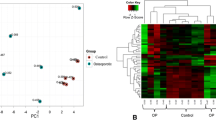Abstract
Osteoporosis, the condition of decreased bone density resulting in bone porosity, brittleness, and a increased fracture risk is rising with aging. Current treatments slow-down bone loss but cannot increase bone formation and quality. Using osteoblasts–the bone forming cells–and RNAi libraries, we developed a high-content analysis approach which identified osteoblast modulators. Several among them are potential drug targets, to induce increase in bone formation thus efficiently combating osteoporosis.
Similar content being viewed by others
Literatur
Melton LJ, Atkinson EJ, O’Connor MK et al. (1998) Bone density and fracture risk in men. J Bone Miner Res 13:1915–1923
Kanis JA, Johnell O, Oden A et al. (2000) Long-term risk of osteoporotic fracture in Malmö. Osteoporos Int 11:669–674
Karsenty G (2017) Update on the biology of osteocalcin. Endocr Pract 23:1270–1274
Morrison SJ, Scadden DT (2014) The bone marrow niche for haematopoietic stem cells. Nature 505:327–334
Khosla S, Hofbauer LC (2017) Osteoporosis treatment: recent developments and ongoing challenges. Lancet Diabetes Endocrinol 5:898–907
Zaidi M (2007) Skeletal remodeling in health and disease. Nat Med 13:791–801
Kroll T, Schmidt D, Schwanitz G et al. (2016) High-content microscopy analysis of subcellular structures: assay development and application to focal adhesion quantification. Curr Protoc Cytom 77:12.43.1–12.43.44
Ahmad M, Kroll T, Jakob J et al. (2018) Cell-based RNAi screening and high-content analysis in primary calvarian osteoblasts applied to identification of osteoblast differentiation regulators. Sci Rep 8:14045
Aenlle KK, Curtis KM, Roos BA et al. (2014) Hepatocyte growth factor and p38 promote osteogenic differentiation of human mesenchymal stem cells. Mol Endocrinol 28:722–730
Américo-Da-Silva L, Diaz J, Bustamante M et al. (2018) A new role for HERPUD1 and ERAD activation in osteoblast differentiation and mineralization. FASEB J 32:4681–4695
Author information
Authors and Affiliations
Corresponding author
Additional information
Torsten Kroll 1991–1997 Chemie-Studium an der Universität Jena und der University of Kent, Canterbury, UK. 1997–2004 Promotion zum Dr. rer. nat. am Hans-Knöll-Institut Jena und der Universität Jena. 2004–2012 Wissenschaftlicher Mitarbeiter am Universitätsklinikum Jena. 2012–2015 Forschungsingenieur am Leibniz Institut für Alternsforschung–Fritz-Lipmann- Institut (FLI) Jena. Seit 2016 Manager der Core Facility Functional Genomics am FLI Jena.
Aspasia Ploubidou 1993–1998 Promotion (Ph.D.) der Biologie an der University of Manchester, UK. 1998–2004 Postdoc-Aufenthalt am Europäischen Laboratorium für Molekularbiologie (EMBL), Heidelberg. Seit 2005 Gruppenleiterin am Leibniz Institut für Alternsforschung–Fritz Lipmann Institute, Jena. 2007–2015 Gründung und Leitung der Core Facility „Functional Genomics“ am FLI in Jena.
Mubashir Ahmad 2004–2009 Bachelor und Masterstudium der Biochemie. 2012–2018 Promotion zum Doktor der Naturwissen - schaften am Institut für Molekulare Endokrinologie der Tiere der Universität Ulm. Seit 2018 Postdoc am Institut für Molekulare Endo krinologie der Tiere der Universität Ulm
Jan Tuckermann 1989–1995 Diplom-Biologiestudium an der Universität Karlsruhe. 1996–1999 Promotion zum Doktor der Naturwissenschaften am Deutschen Krebsforschungszentrum und der Universität Karlsruhe. 1999–2004 Postdoc-Aufenthalt am Deutschen Krebsforschungszentrum Heidelberg. 2004–2012 Juniorgruppenleiter am Leibniz Institut für Alternsforschung–Fritz-Lipmann-Institut Jena. Seit 2012 W3-Universitätsprofessor für Zoologie und Endo - krinologie und Leiter des Instituts für Molekulare Endo - krinologie der Tiere, Universität Ulm.
Rights and permissions
About this article
Cite this article
Kroll, T., Ahmad, M., Ploubidou, A. et al. RNAi-Screening in Knochenbildenden Zellen. Biospektrum 25, 523–526 (2019). https://doi.org/10.1007/s12268-019-1091-1
Published:
Issue Date:
DOI: https://doi.org/10.1007/s12268-019-1091-1




